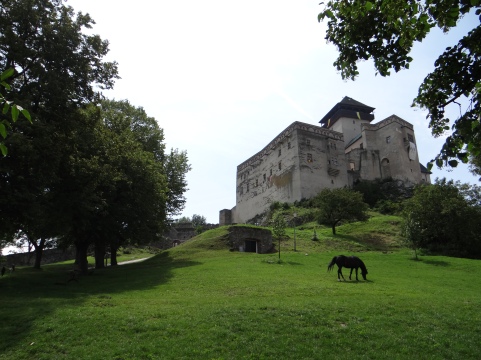I arrived in Slovakia and texted my mom “Made it to Bratislava!”
Her response: “Where? What country is that?”
This seems to be the central problem of Slovakia. No one knows where or who this country is since they split from the Czech Republic during the Velvet Divorce of 1989. George W. Bush was there during his presidency and congratulated Slovenia on their transition to a democratic state after so many years of Communism. Major international newspapers have even published maps featuring Slovenia in their place, or simply written Czechoslovakia.
The Slovaks are not impressed, world.
Nearly every person I met in Bratislava asked me that if I liked Slovakia, would I please tell everyone I know to come and visit the country and see for themselves why it is so great? Apparently, after the movie The Hostel came out, telling the (fictional) story of several international travelers who wanted cheap beer and hot girls in Slovakia but instead were ax-murdered brutally, tourism went down 75%! I am here to tell you that nothing remotely horrible happened to me in Slovakia, and I had more than one local tell me they would personally sew me back up if I was ax-murdered.

Not only did I not hate my time in Slovakia, I loved it! Friendly, beautiful, laidback and full of history, Bratislava is a must-see if you are in the area, even if you can’t stay more than a half day. Though I lingered longer, Bratislava is an easy city to sweep through on your way to and from Prague, Vienna or Budapest by train bus or boat. And it’s a great place to get an even more robust context for the history that touches the whole region – including Communism and the Austro-Hungarian Empire – while you’re relishing the cheap cost of living and traveling in Southeastern Europe.

When Czechoslovakia was a single country within the Soviet Block, Prague was the cultural capital and Bratislava the industrial capital of the nation. Today, one can still see the traces of this division when comparing the two capitals, but that does not mean Bratislava is lacking for history or beauty. In fact, in 1536 Bratislava became the capital of the Kingdom of Hungary and over the course of the next 300 years, 11 Hungarian kings and queens were crowned in St. Martin’s Cathedral in the Old Town. You’ll find remnants of the Medieval town gate and cannon balls still wedged into the buildings of the 14th-15th Century Old Town Square from when Napoleon showed up.
It is a town with plenty of modern contradictions though: you can climb the hill to the newly-fully renovated Bratislava Castle and see across the river to the Communist suburbs, where miles of blocky high rises remind you of another era, not so recently passed. You’ll pass beautiful 18th Century opera houses and ornate churches, right next to abandoned Soviet-era hospitals, covered in graffiti and statues of the working man. Then you’ll come upon beautiful, tree-lined boulevards and busy central squares, filled with bean bag chairs and music in the summer evenings.
I started my time in Bratislava in the same way I always do when I arrive in a new city: I find the quickest Free Walking Tour so that I can to get myself situated physical and culturally. I quickly found that every local I met in Slovakia was warm and friendly, eager to know about me and to tell me about their country. From wine makers to hostel workers, it seemed true of these less-traveled countries that overall the locals were much more friendly to tourists than some Western European locations I’ve explored.
The other great treat of Slovakia was that the food was perhaps some of the best I’ve had in all of Europe! From pirohy (pierogi-like dumplings filled with cheese) to halušky (tiny gnocchi-like potato bites covered in rich, sharp sheep’s cheese and topped with bacon) I found myself relishing in rich comfort foods, even on hot summer days. And like most of the region, beer is cheaper than water, so you’ve always got something cool to wash it down with. I’d recommend stopping in the Slovak Pub just outside Old Town, where you’ll sit in rooms designed to look like traditional Slovak houses across the ages. It’s a popular place with tourists and students, but food is reasonably priced and they have their own organic garden from which they source produce.
Pro Tip: As with most European cities, you’ll be disappointed if you show up on a Monday (like I did) to find every museum, including the castle and even the pub crawl offered through my walking tour company, closed.
Trenčín, Slovakia
 After a full day in Bratislava, I caught a train and headed northeast about an hour and a half to Trenčín, a small city in the foothills of the mountains which continue east to border the Czech Republic and Poland. I wanted to see a bit more of the country, and I had read about the impressive castle on the hill above the city. Outside the castle, there were falconers giving demonstrations, and inside my 13-year-old heart skipped a beat as I wandered the winding stairwells and explored the high-ceiling rooms. At the top of the turrets, flags whipped and snapped in the mountain breezes. It felt as delightfully traditional as it gets, larger, sunnier and more intact than castles I’d seen in countries like Ireland, and amazingly nearly empty of tourists.
After a full day in Bratislava, I caught a train and headed northeast about an hour and a half to Trenčín, a small city in the foothills of the mountains which continue east to border the Czech Republic and Poland. I wanted to see a bit more of the country, and I had read about the impressive castle on the hill above the city. Outside the castle, there were falconers giving demonstrations, and inside my 13-year-old heart skipped a beat as I wandered the winding stairwells and explored the high-ceiling rooms. At the top of the turrets, flags whipped and snapped in the mountain breezes. It felt as delightfully traditional as it gets, larger, sunnier and more intact than castles I’d seen in countries like Ireland, and amazingly nearly empty of tourists.

Perhaps a little gritty around the edges at first, once you find your way into the Old Town you’ll be charmed by Bratislava’s history and walk-ability. It’s easy to see in an afternoon or a day, but if you’re looking for an affordable, laid back place to recuperate and relax on the shores of the Danube, the small size of Bratislava makes it ideal for recovery from the hustle and stimulation of Prague or Budapest.

